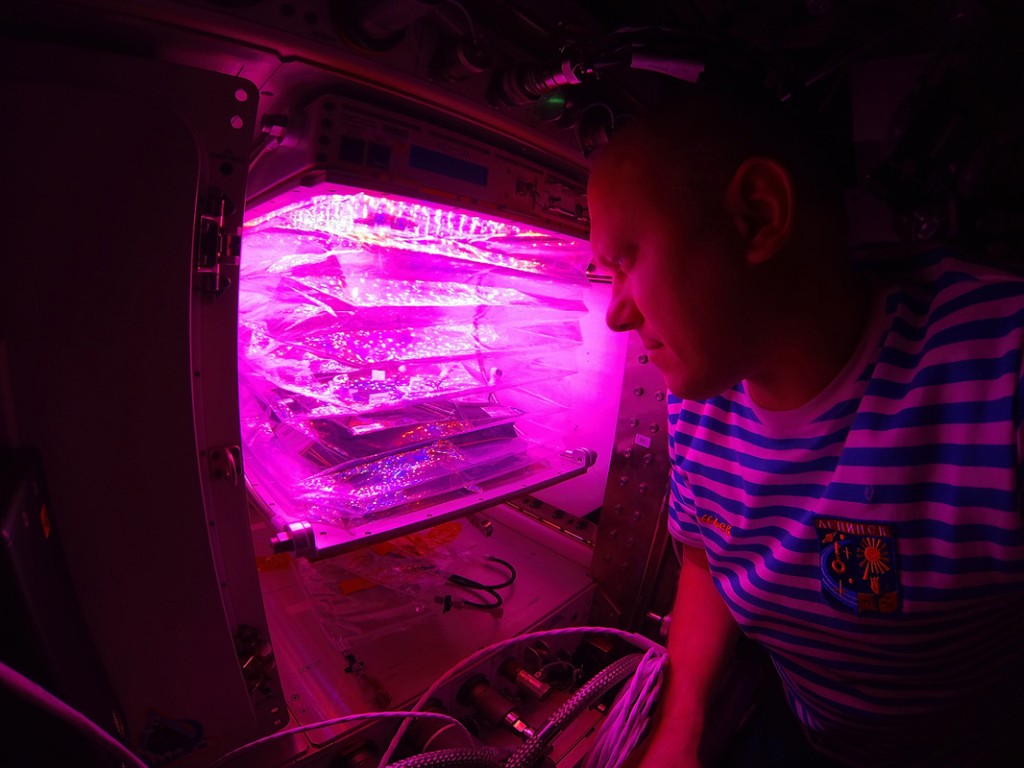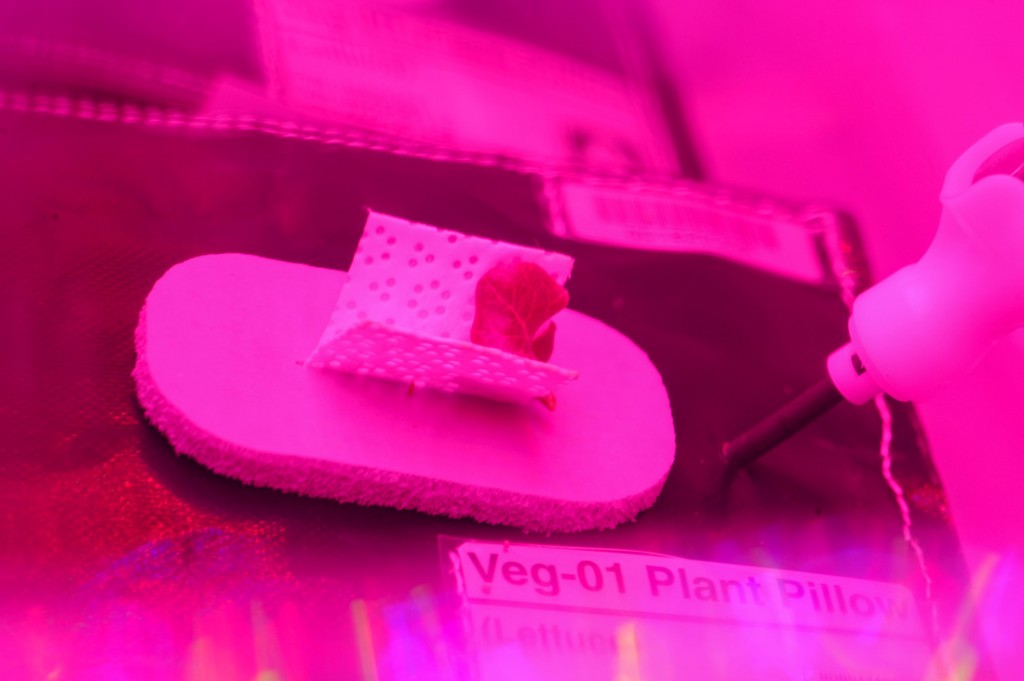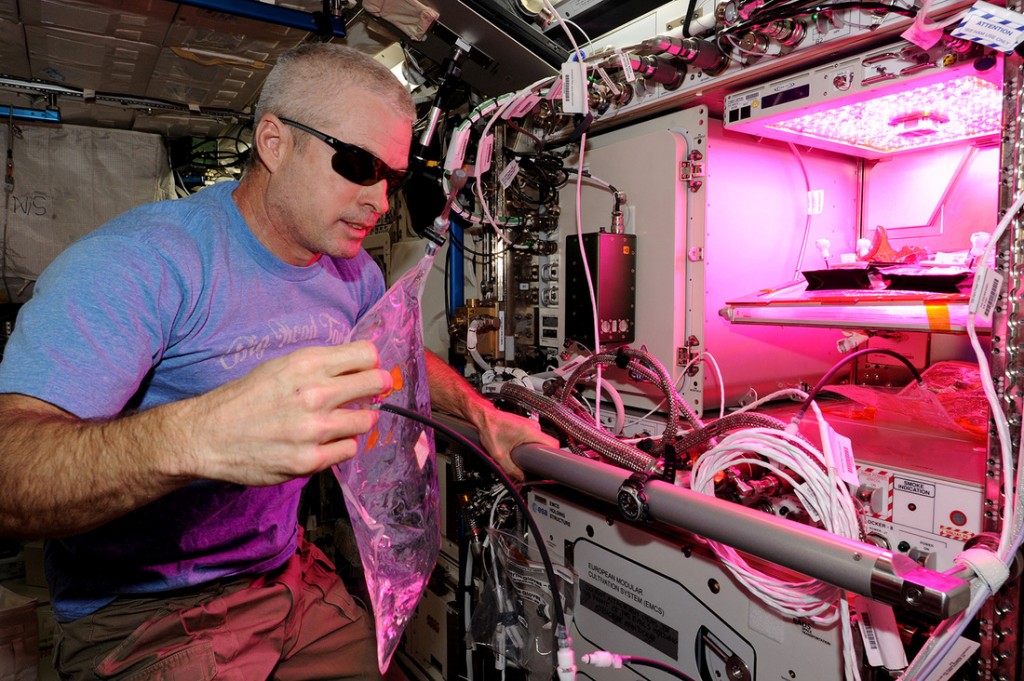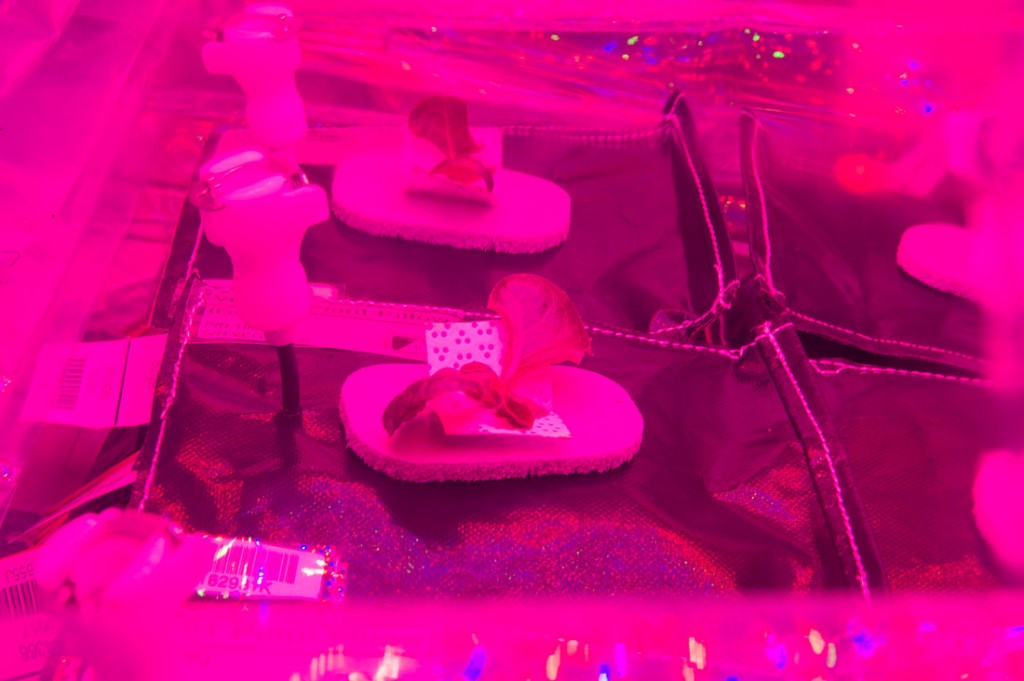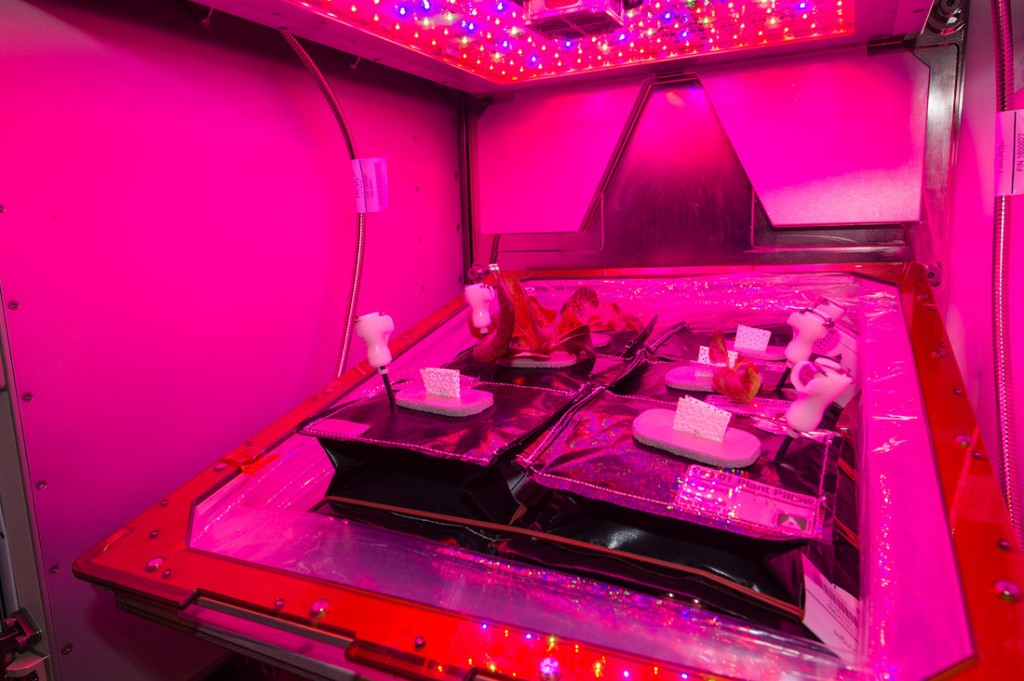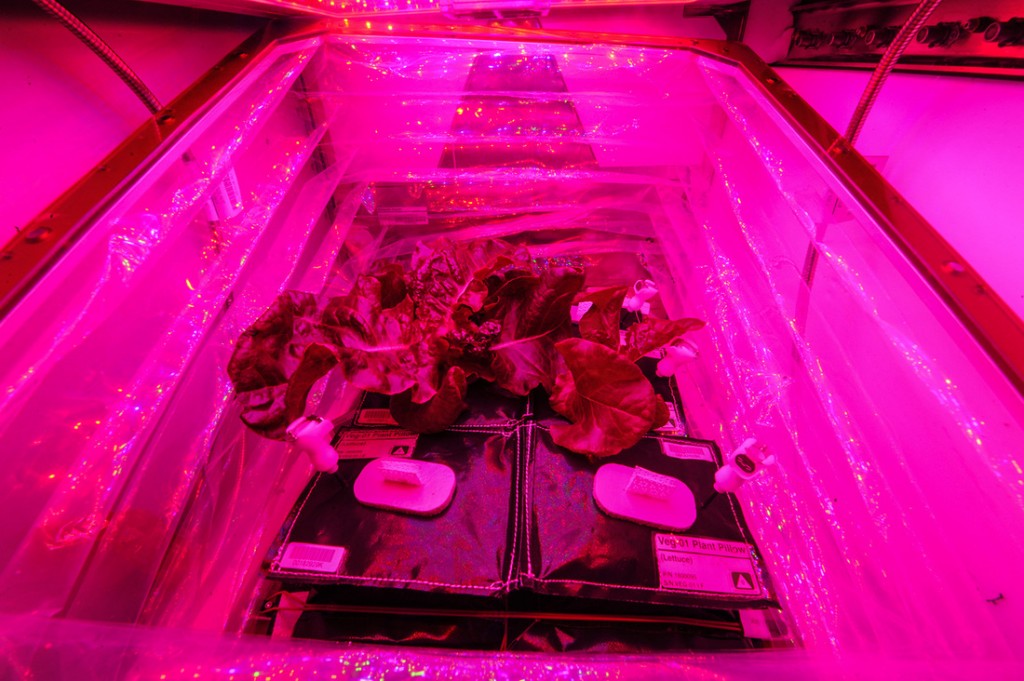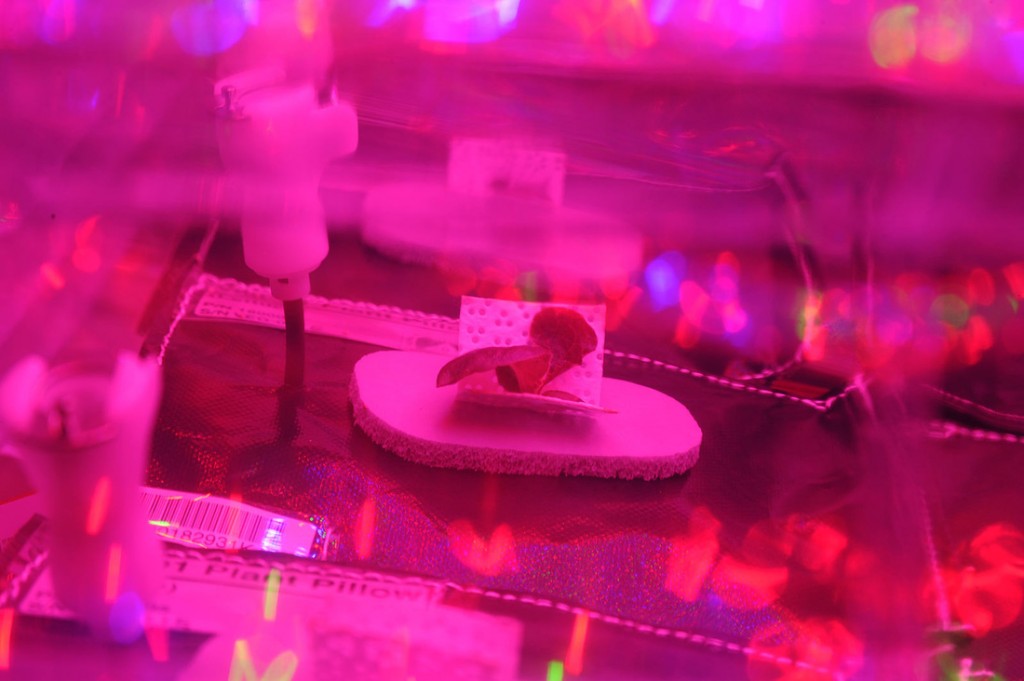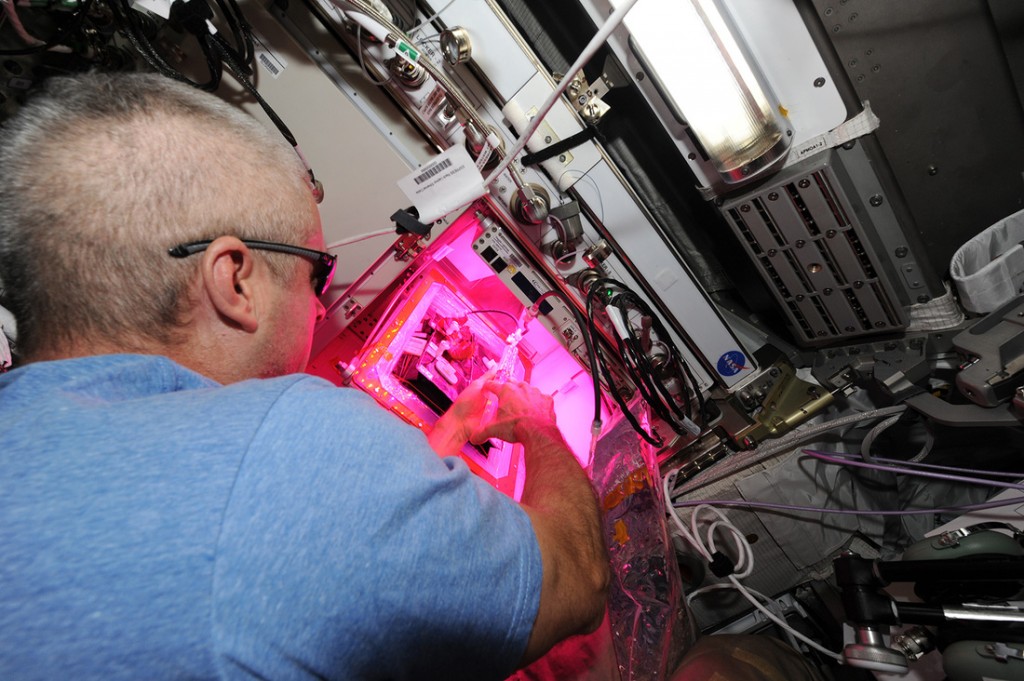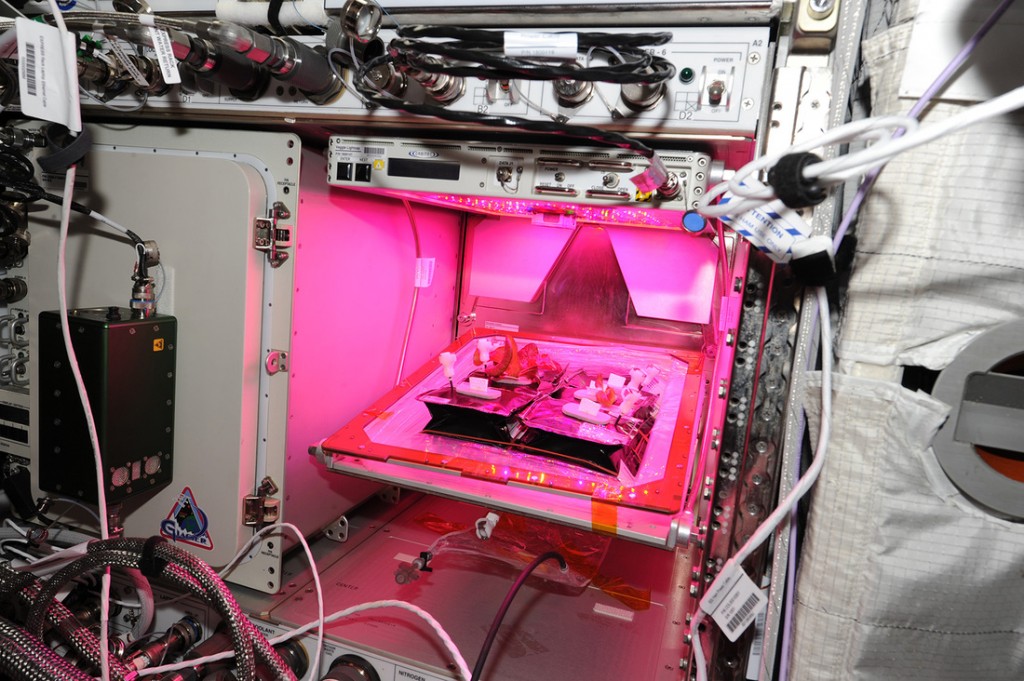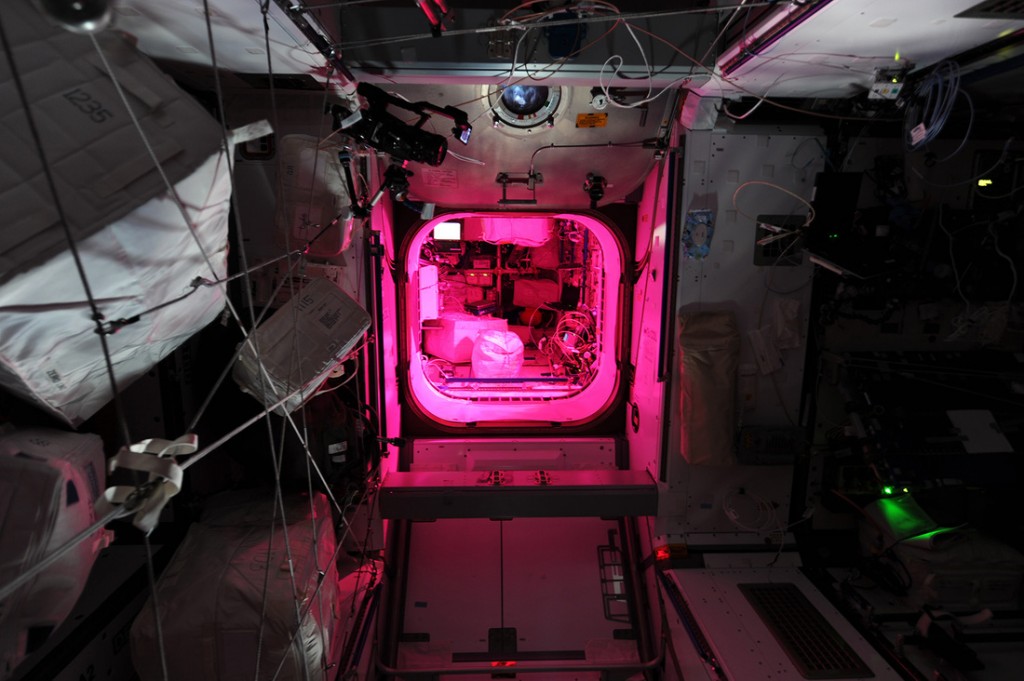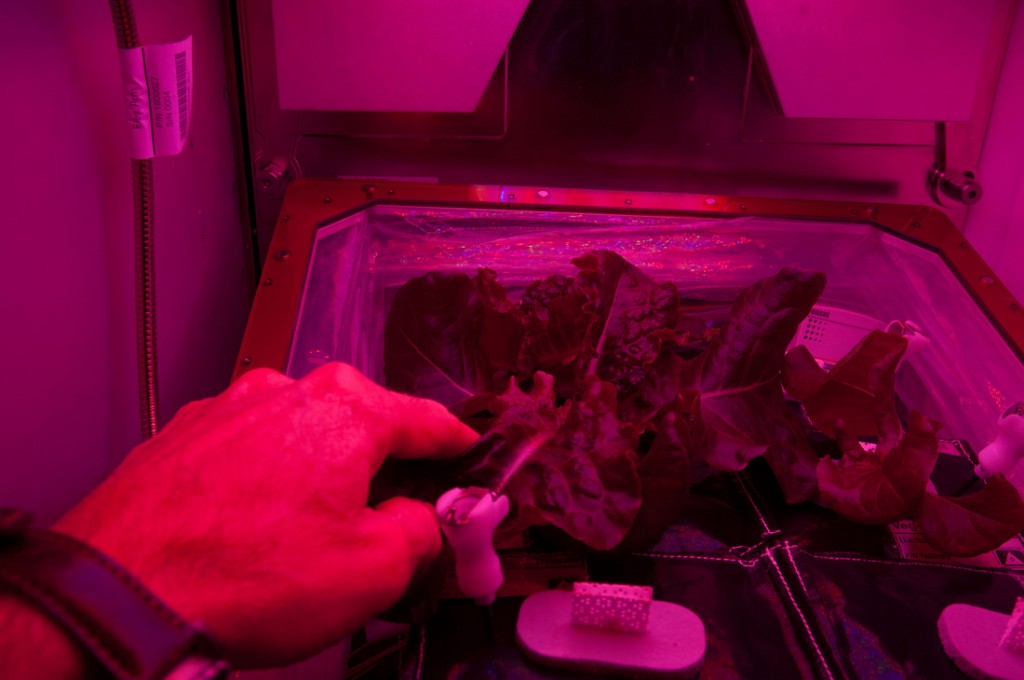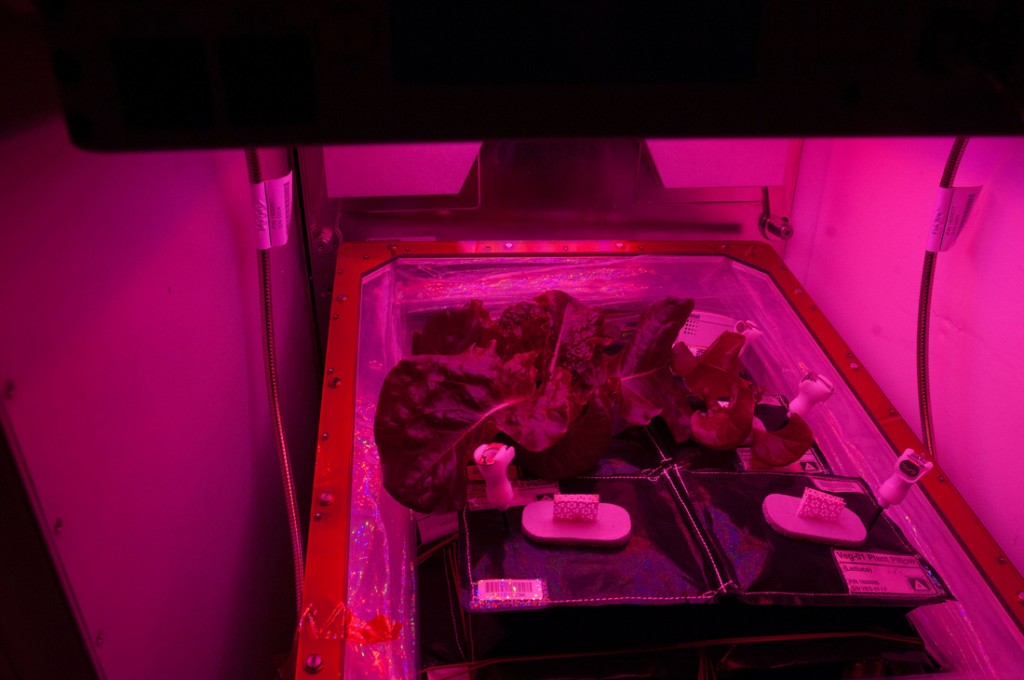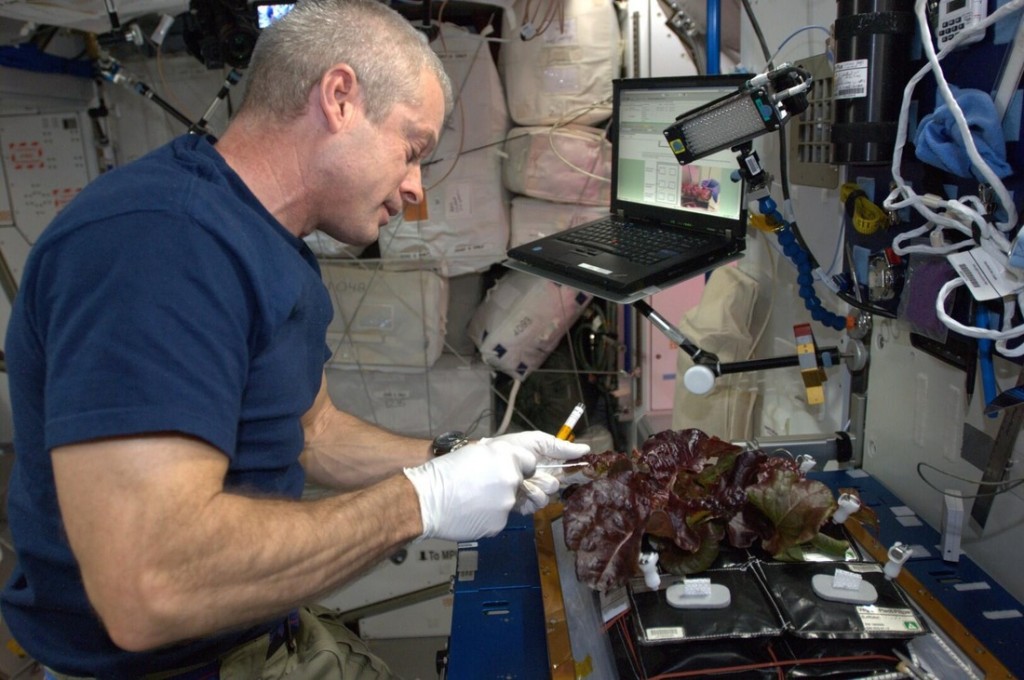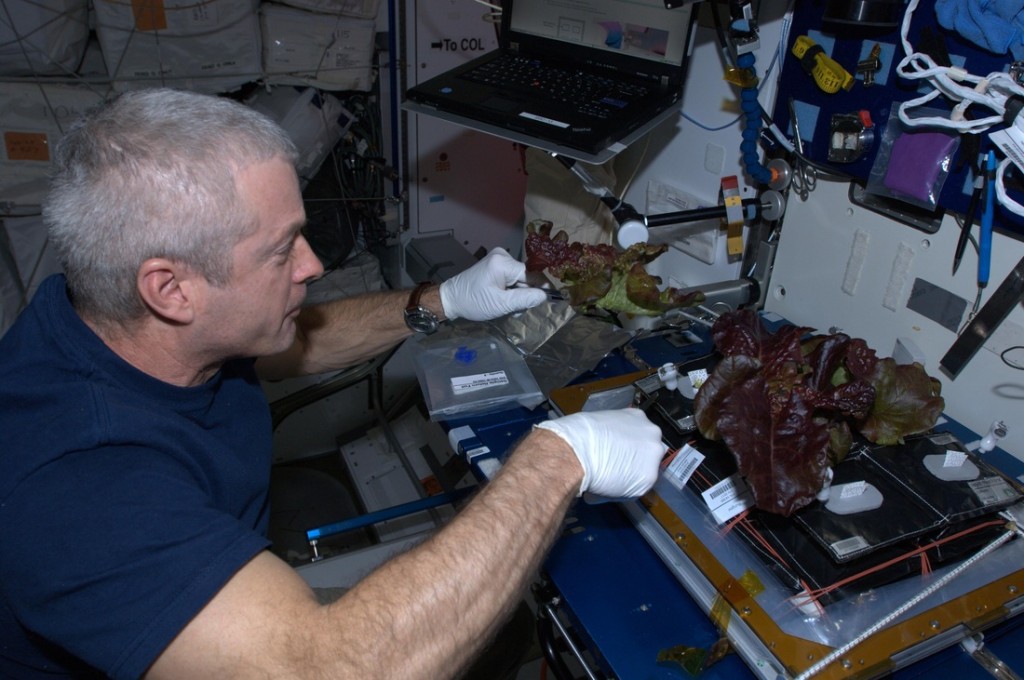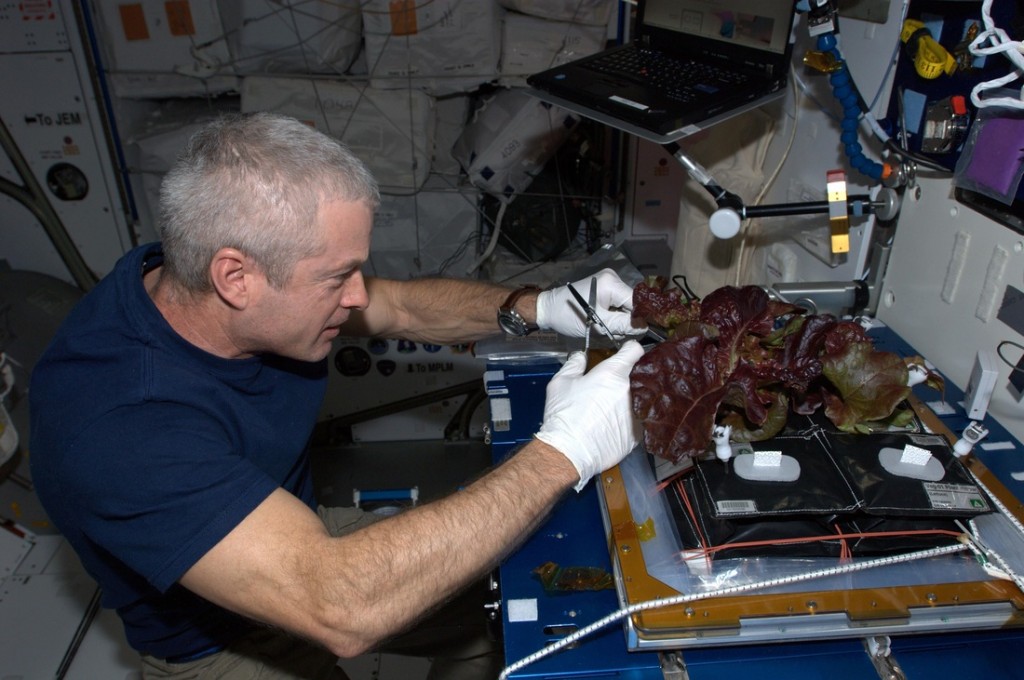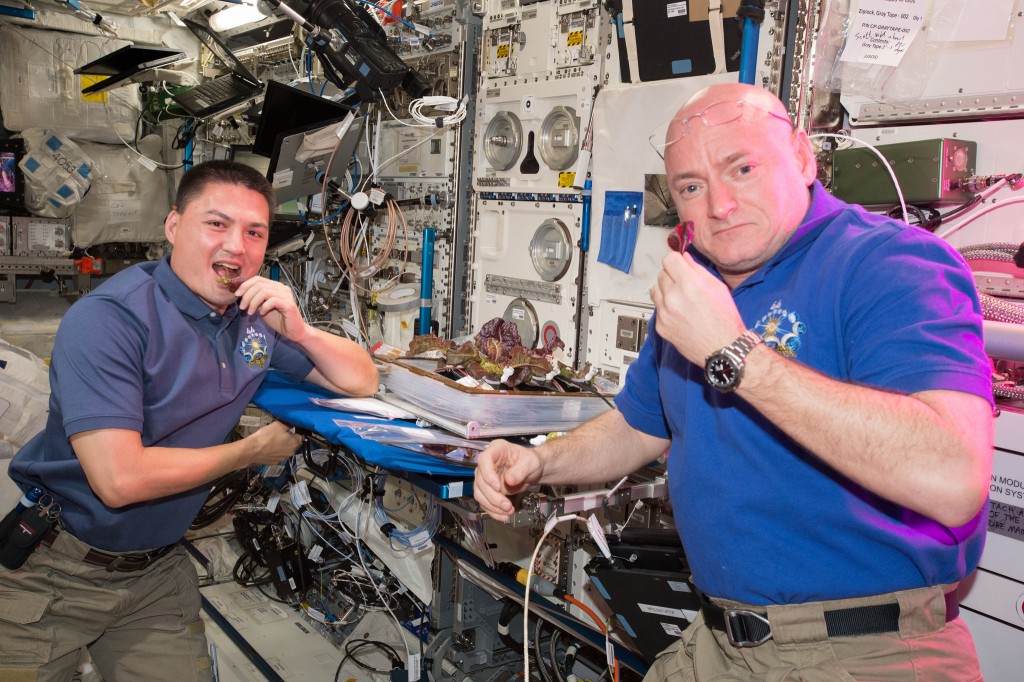Veggie (VEG) - ISS Plant-Growth Facility

VEGGIE is a deployable plant growth unit to be set up on the Space Station to demonstrate the feasibility of a space garden. The experiment facility provides lighting and nutrient supply and is capable of supporting a variety of plant species that can be cultivated for educational outreach, fresh food and even recreation for crewmembers on long-duration missions. Thermal control is provided from ISS in-cabin systems and the carbon dioxide source is the ambient air aboard ISS.
Veggie uses a plant growth chamber using planting pillows and an LED bank to provide lighting. Ground testing of the pillow planting concept led to the selection of growth media and fertilizers, plant species, materials, and protocols. The facility weighs 7.2 Kilograms and measures 53 by 40 centimeters and permits a maximum growth height of 45 centimeters. The root mat has a growing area of 0.16m² with a 2-liter fluid reservoir.

The Veggie experiment facility provides lighting and nutrient supply and is capable of supporting a variety of plant species that can be cultivated for educational outreach, fresh food and even recreation for crewmembers on long-duration missions. Thermal control is provided from ISS in-cabin systems and the carbon dioxide source is the ambient air aboard ISS.
The system draws 115W of peak power and its LED banks can support adjustable wavelengths, light levels and day and night cycles to match the biological needs of the plants. A transparent teflon cover allows viewing of the plants. The plants will be photographed regularly to assess plant growth rates and health. Tissue samples will provide information on possible growth anomalies when being compared to ground controls. Environmental data will be provided by a data logger that measures temperature, humidity and pCO2.
The first studies performed with VEGGIE will also provide microbial samples of the plants and pillows to assess the level of microbial contamination and implement corrective measures if needed. For most species, microbial contamination levels will be well within limits and pose no threat to the crew. Other species that naturally have higher levels of microorganisms may need a sanitation method which must be developed and tested as part of the experiment. Growing plants in space provides crewmembers with fresh foods to supplement their diets, as well as a positive effect on morale and well-being.
Veg-01 & 02

Plants grown in the Veg-01 facility will be observed to determine how plants sense gravity and how they respond to microgravity. Serving as a pathfinder, the plants grown as part of VEGGIE will be harvested and studied before being cleared for consumption by crew members in orbit. The VEGGIE facility is the largest volume available aboard ISS for plant growth, which will allow the study of larger plants that could not be grown in previous experiments.
The test species to be used in Veg-01 will be lettuce that will be grown in two different sizes of arcillite, a calcined clay media, to compare root zones between the two media zones to determine water and root distribution for future investigations. The plants will be photographed regularly to assess plant growth rates and health. Tissue samples will provide information on possible growth anomalies when being compared to ground controls. Environmental data will be provided by a data logger that measures temperature, humidity and pCO2.

Veg-03

Veg-03 marks the second operational deployment of the VEGGIE Plant Growth Unit that was first used in the first half of 2014 to grow red romaine lettuce plants as part of a proof of concept of the Plant Growth Unit including two different sizes of arcillite, a calcined clay media in which the plants were grown.
Veg-01 provided valuable data in the form of returned water samples and root pads, imagery acquired in orbit of the growth process, and plant samples that were brought back to Earth. This data helped investigators assess the two different growth media with respect to water and root distribution within the different sized particles to chose media for future Veggie missions.
Furthermore, samples returned to Earth provided information on the microbial load of the plants to assess their safety for potential crew consumption and photographs taken over the course of the experiment allowed scientists to asses growth rate and plant health.
Additionally, two data loggers kept track of temperature and humidity within the Plant Growth Unit and questionnaires were performed by the crew to gather information on possible improvements of Veggie experiment procedures.

Although the overall Veg-01 experiment was a success, a number of deficiencies with regard to the plant pillows and the water delivery systems were identified leading to modifications made to the pillows and watering procedures that will be tested by Veg-03, also introducing a different crop with different water requirements.
Ground testing of the Plant Growth Facility showed a very low microbial contamination of plants that were grown within it and the Veg-01 experiment samples also showed a low microbe level with no specific pathogens being detected by ground-based testing. Assessments were conducted by microbiologists, flight surgeons and space food technicians who concurred that the crew should be able to consume the fresh produce with precautionary sanitizing using on-orbit Prosan wipes. The formal documentation of produce preparations procedures and official approval for consumption are still being documented and will likely await a second set of data from Veg-03 before being finalized.

The overall aim of the Veg-03 study is to deliver more data on the performance of the Plant Growth Unit and the planting pillows. Veg-03 will use Tokyo Bekana cabbage as a test crop, also using two different sizes of clay media to again compare root distribution.
The Veggie experiment facility provides lighting and nutrient supply and is capable of supporting a variety of plant species that can be cultivated for educational outreach, fresh food and even recreation for crewmembers on long-duration missions. Thermal control is provided from ISS in-cabin systems and the carbon dioxide source is the ambient air aboard ISS.
Plants grown in the Veg-03 facility will be observed to determine how plants sense gravity and how they respond to microgravity. Serving as a pathfinder, the plants grown as part of VEGGIE will be harvested and studied before being cleared for consumption by crew members in orbit. The VEGGIE facility is the largest volume available aboard ISS for plant growth, which will allow the study of larger plants that could not be grown in previous experiments.
Veggie Gallery
All Photos: NASA/ESA/Roscosmos

